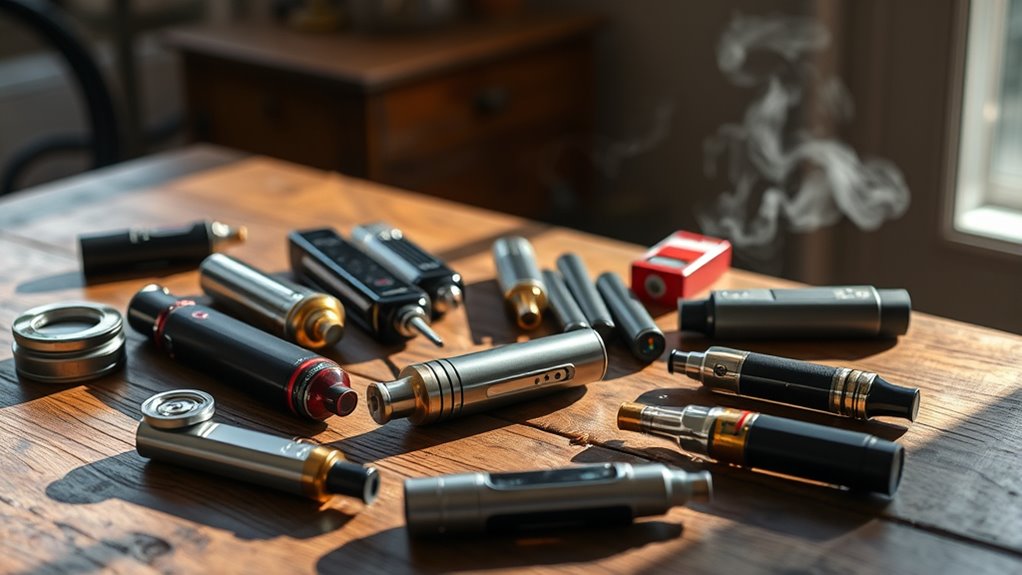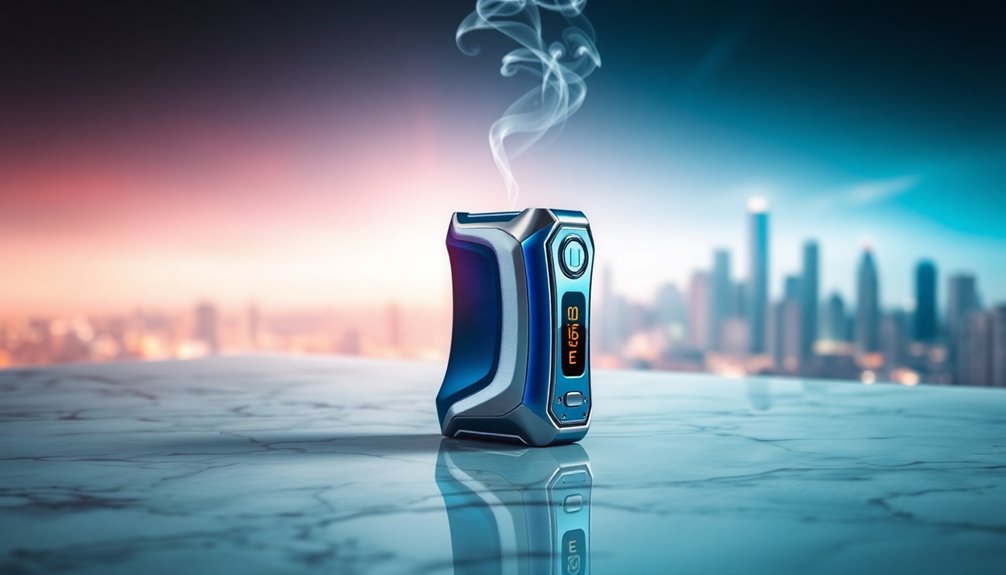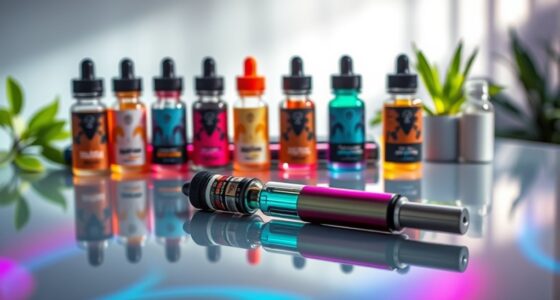The history of vape pens is a fascinating journey, starting with early innovations like Joseph Robinson's electric vaporizer in 1927. Fast forward to 2003, when Hon Lik invented the first successful e-cigarette, paving the way for today's advanced devices. With a surge in youth popularity and ongoing health concerns, vaping has seen significant regulatory challenges. You'll discover how continuous technological advancements keep shaping the vaping landscape and what lies ahead for this ever-evolving industry.
Key Takeaways
- The first electric vaporizer was patented by Joseph Robinson in 1927, paving the way for smoking alternatives.
- Herbert Gilbert introduced the smokeless, non-tobacco cigarette in 1963, addressing health concerns related to traditional smoking.
- The first commercially successful e-cigarette was invented by Hon Lik in 2003, marking a significant milestone in vaping technology.
- Technological advancements have led to innovations like variable voltage devices, pod mods, and personalized AI-driven vaping experiences.
- Regulatory changes, aimed at protecting public health, have influenced vaping product designs and marketing strategies, particularly concerning youth usage.
Early Innovations in Smoking Alternatives

As concerns about the harmful effects of smoking emerged over two centuries ago, innovators began exploring alternatives to traditional tobacco use.
In 1927, Joseph Robinson patented the electric vaporizer, enabling inhalation without burning tobacco. This was a significant step in early innovations in smoking alternatives.
By 1963, Herbert Gilbert introduced the smokeless non-tobacco cigarette, reflecting the growing awareness of smoking-related health issues.
Herbert Gilbert's 1963 smokeless non-tobacco cigarette marked a pivotal moment in recognizing smoking-related health concerns.
The 1980s brought e-cigarette experiments, including Jed Rose's distilled smoke concept, which laid the groundwork for future developments.
The introduction of the tabletop Volcano vaporizer in 2000 further advanced these alternatives, mainly focusing on marijuana consumption.
These early innovations provided valuable options for those seeking smoking cessation aids while addressing health concerns associated with traditional tobacco products.
The Development of Modern E-Cigarettes

When you look at the evolution of modern e-cigarettes, you'll notice key milestones that shaped their design and functionality.
Innovations like JUUL changed the game, particularly for younger users, while regulatory shifts have influenced how these products are marketed and sold.
Understanding these factors is essential to grasping the vaping landscape today.
Key Milestones in Development
The journey of modern e-cigarettes began in 2003 with Hon Lik's invention of the first commercially successful e-cigarette, driven by his desire to offer a safer nicotine delivery system. This innovation marked the start of a significant shift in the history of tobacco harm reduction.
By 2006, electronic cigarettes reached Europe, and in 2007, they debuted in the U.S., providing an alternative to traditional smoking. E-liquids, primarily made of propylene glycol and vegetable glycerin, along with varying flavors and nicotine, fueled the vaping trend.
JUUL emerged as a leading brand, attracting young consumers, which led to rising teen vaping rates. By 2021, the global e-cigarette market had over 82 million users, highlighting the perceived health effects and appeal of vaping.
Technological Advancements Over Time
While the invention of the modern e-cigarette in 2003 marked a significant turning point, it's the technological advancements over the years that have truly shaped the vaping landscape.
Early electronic cigarettes mimicked traditional cigarettes, but newer designs introduced variable voltage and sub-ohm tanks for improved performance.
Today, you can enjoy over 15,000 e-liquid flavors, enhancing customization and appeal. Additionally, pod mod devices now utilize protonated nicotine, making them more efficient for both former smokers and recreational users.
The rise of vaping as a popular choice reflects a shift towards safer nicotine replacement therapy products, steering clear of harmful chemicals found in tobacco.
As usage skyrocketed from 7 million in 2011 to 82 million in 2021, innovation continues to drive this dynamic market.
Regulatory Changes Impacting Design
As vaping technology evolved, so did the regulatory landscape surrounding it. The introduction of modern e-cigarettes brought significant scrutiny from health organizations and governments.
Regulatory changes aimed to curb nicotine addiction and protect public health have shaped designs dramatically. You might feel concerned about:
- The health risks associated with unregulated nicotine delivery
- Tobacco companies' marketing practices targeting youth
- The ban on flavored e-cigarettes to reduce youth vaping
- The need for clearer labeling and transparency in product formulations
These regulations emerged after studies revealed potential dangers, prompting the FDA to classify e-cigarettes as combination drug-device products.
As a result, manufacturers have had to adapt their designs to comply with these evolving standards, ultimately shifting the landscape of vaping.
The Rise of Vaping Popularity
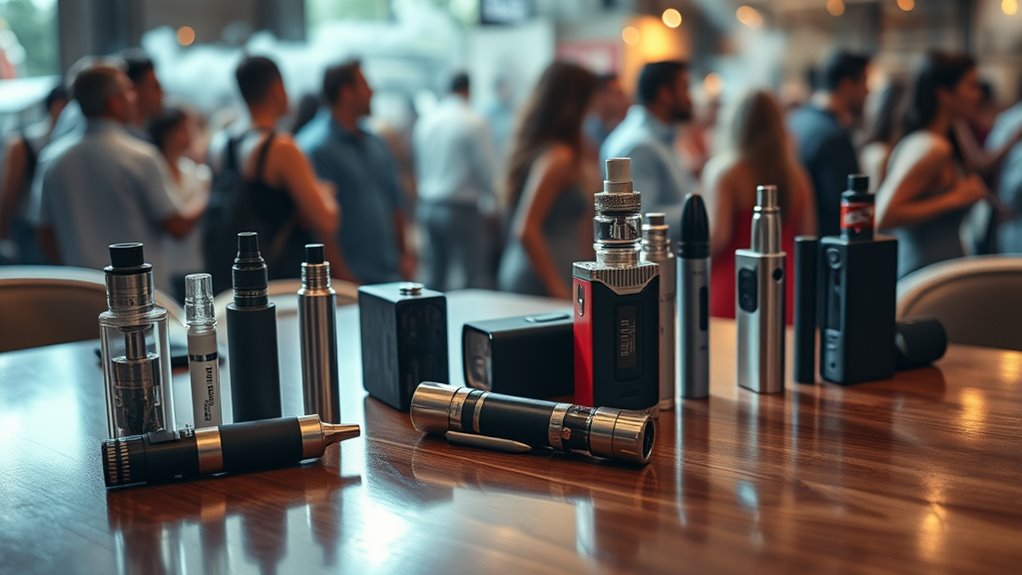
Vaping's popularity has skyrocketed over the past decade, capturing the attention of millions worldwide. The surge in e-cigarette users from 7 million in 2011 to 82 million in 2021 highlights this shift toward vaping as a preferred alternative to traditional tobacco.
It's particularly noticeable among youth; many teenagers who've never touched a cigarette now embrace e-cigarettes. This trend largely stems from effective marketing strategies and the allure of over 15,000 unique flavors.
While some perceive vaping as a less harmful option, it's essential to recognize the ongoing concerns about health risks. Notably, as e-cigarette use rises, traditional tobacco consumption among youth has declined by about 75%, indicating a complex relationship between vaping and smoking behaviors.
Health Concerns and Regulatory Challenges

The rapid rise in vaping popularity brings with it a host of health concerns and regulatory challenges.
As you navigate this landscape, consider the alarming facts:
- E-cigarette use links to chronic obstructive pulmonary disease and asthma.
- Over 1,888 people suffered mysterious lung injuries, with at least 37 deaths reported.
- Many vaping products contain unknown chemicals due to insufficient federal oversight.
- Research indicates e-cigarettes may activate cancer genes.
Public Health Physicians stress the need for stricter regulations, yet the Food and Drug Administration struggles to keep pace.
While debates on flavored e-cigarette bans have surfaced, real change remains elusive.
It's essential to stay informed about these risks, as your health could be at stake.
The Impact of Vaping on Youth
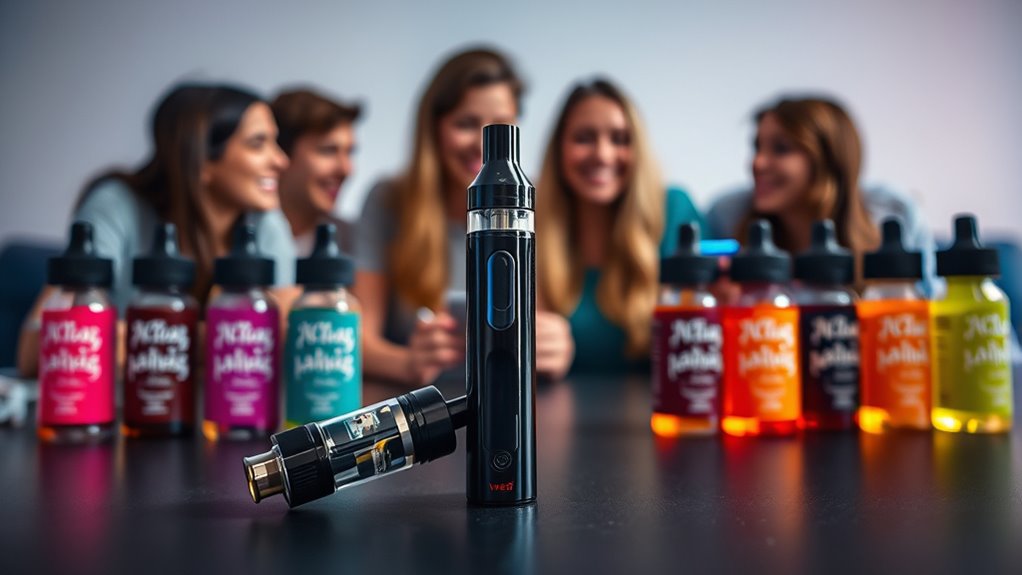
With youth e-cigarette use skyrocketing in recent years, the implications for public health have become increasingly concerning. Over 3.6 million high school students reported using e-cigarettes in 2020, a significant jump from previous years.
What's alarming is that about 60% of these young users have never smoked traditional tobacco. The sleek design and appealing flavors of products like JUUL have popularized vaping among teens, leading to a 75% drop in tobacco smoking rates.
However, this decline raises concerns that vaping could serve as a gateway to smoking. Studies show adolescent e-cigarette users are more likely to become regular smokers, highlighting the potential risks of nicotine addiction and long-term health impacts on today's youth.
The Future of Vape Pens and Technology
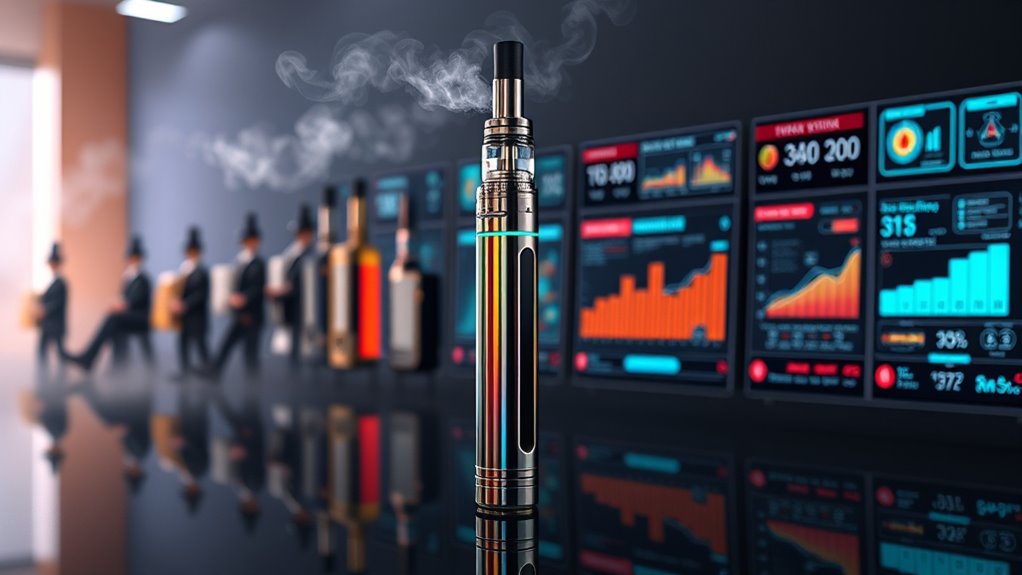
As you look ahead, the future of vape pens promises exciting advancements in battery technology, allowing for longer usage and quicker charging.
You'll also see smart vaping features that let you track your habits and customize your experience through apps.
Plus, innovations in e-liquid formulations are set to enhance your vaping journey, making it smoother and more satisfying than ever.
Advancements in Battery Technology
Advancements in battery technology have revolutionized vape pens, enhancing both user experience and device performance. The shift to lithium-ion and built-in rechargeable batteries means you can enjoy longer usage times and faster charging, making your vaping experience smoother than ever.
Here are some key benefits:
- Longer battery life means less time charging and more time vaping.
- Faster charging lets you get back to your sessions quickly.
- Customizable settings like variable wattage optimize flavor and vapor production.
- Sustainability is improved, as fewer disposable batteries end up in landfills.
With ongoing innovations in battery technology, including the potential for even smaller devices, you're set to enjoy an enhanced vaping experience that prioritizes convenience and efficiency. Additionally, the integration of air purifier maintenance techniques can further enhance the overall health benefits of vaping by ensuring a cleaner environment for use.
Smart Vaping Features
Battery technology has paved the way for the next wave of innovation in vape pens, introducing smart features that enhance the overall user experience.
These modern devices often come with advanced temperature control, preventing overheating and guaranteeing you enjoy every puff without harmful chemicals.
With Bluetooth connectivity, you can monitor usage and adjust settings through mobile apps, providing real-time information at your fingertips.
Some vape pens now feature customizable LED displays that show battery life, puff count, and temperature settings, giving you complete control.
Additionally, AI integration allows for personalized vaping profiles, adapting to your preferences and habits.
This combination of technology guarantees a tailored experience that evolves with you, making your vaping journey more enjoyable and efficient than ever.
E-Liquid Innovations
While the evolution of vape pens has focused heavily on hardware, the true game-changer lies in e-liquid innovations that are reshaping the vaping landscape.
Today's e-liquids offer more than just flavors; they enhance your overall vaping experience with:
- Over 15,000 unique flavors for endless customization.
- Protonated nicotine for higher yields and greater satisfaction.
- Reduced harmful chemicals, prioritizing your safety.
- Terpene profiles that mimic cannabis strains, appealing to diverse users.
These innovations not only elevate enjoyment but also address concerns about harmful chemicals, making vaping a safer alternative.
As technology advances, expect even more personalized experiences, enabling you to control every aspect of your vaping journey, from flavor to nicotine levels.
The future's looking bright!
Frequently Asked Questions
How Has the Vaping Industry Evolved Over the Years?
The vaping industry's evolved markedly over the years.
You've seen it shift from a niche product to a mainstream alternative to smoking. With a staggering number of e-cigarette users worldwide, you can't ignore the explosion of e-liquid flavors catering to every taste.
However, as popularity surged, so did concerns about health and youth addiction, leading to stricter regulations.
This dynamic landscape continues to shape your choices and experiences as a consumer.
What Was Vaping's Original Purpose?
Vaping's original purpose was to provide a safer alternative to traditional smoking. It aimed to deliver nicotine without the harmful chemicals generated by burning tobacco.
When you choose to vape, you're engaging in a method designed to help smokers shift away from combustible products. Initially, it was marketed as a tool for smoking cessation, targeting those looking to reduce health risks while still satisfying their nicotine cravings.
What Does 5 Years of Vaping Do to Your Body?
After five years of vaping, about 30% of users report chronic respiratory issues, including asthma or COPD.
You might notice persistent throat irritation, headaches, and even abdominal pain becoming more common. Your lung function could decline similarly to traditional smokers, increasing your risk of cardiovascular problems as nicotine elevates your heart rate.
Long-term exposure may also trigger inflammation in your lungs, making you more vulnerable to respiratory infections and other health complications.
When Did People Start Using Vapes?
You started seeing people use vapes around 2007 when e-cigarettes became commercially available in the U.S. This followed their introduction to Europe in 2006.
By 2011, the vaping community had grown considerably, with millions turning to e-cigarettes as an alternative to traditional smoking.
As awareness of vaping increased, so did its popularity, making it a common choice for those looking to quit smoking or seek a different way to inhale nicotine.
Conclusion
As you explore the journey of vape pens, you see they've evolved from simple smoking alternatives to a complex cultural phenomenon. Like a river carving its path through the landscape, vaping has shaped social interactions and raised health concerns along the way. While the future remains uncertain, one thing's clear: vape pens are here to stay, adapting and changing with our needs. Embrace the evolution, but stay informed to navigate the currents safely.

